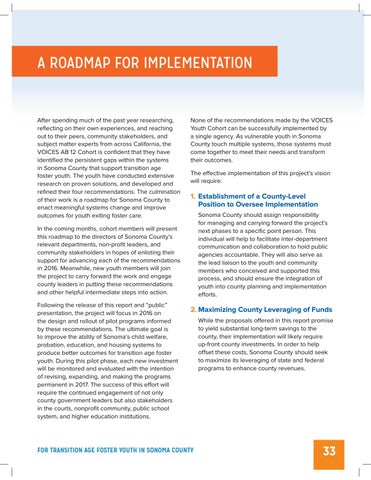A ROADMAP FOR IMPLEMENTATION
After spending much of the past year researching, reflecting on their own experiences, and reaching out to their peers, community stakeholders, and subject matter experts from across California, the VOICES AB 12 Cohort is confident that they have identified the persistent gaps within the systems in Sonoma County that support transition age foster youth. The youth have conducted extensive research on proven solutions, and developed and refined their four recommendations. The culmination of their work is a roadmap for Sonoma County to enact meaningful systems change and improve outcomes for youth exiting foster care.
None of the recommendations made by the VOICES Youth Cohort can be successfully implemented by a single agency. As vulnerable youth in Sonoma County touch multiple systems, those systems must come together to meet their needs and transform their outcomes. The effective implementation of this project’s vision will require:
1. Establishment of a County-Level Position to Oversee Implementation Sonoma County should assign responsibility for managing and carrying forward the project’s next phases to a specific point person. This individual will help to facilitate inter-department communication and collaboration to hold public agencies accountable. They will also serve as the lead liaison to the youth and community members who conceived and supported this process, and should ensure the integration of youth into county planning and implementation efforts.
In the coming months, cohort members will present this roadmap to the directors of Sonoma County’s relevant departments, non-profit leaders, and community stakeholders in hopes of enlisting their support for advancing each of the recommendations in 2016. Meanwhile, new youth members will join the project to carry forward the work and engage county leaders in putting these recommendations and other helpful intermediate steps into action. Following the release of this report and “public” presentation, the project will focus in 2016 on the design and rollout of pilot programs informed by these recommendations. The ultimate goal is to improve the ability of Sonoma’s child welfare, probation, education, and housing systems to produce better outcomes for transition age foster youth. During this pilot phase, each new investment will be monitored and evaluated with the intention of revising, expanding, and making the programs permanent in 2017. The success of this effort will require the continued engagement of not only county government leaders but also stakeholders in the courts, nonprofit community, public school system, and higher education institutions.
2. Maximizing County Leveraging of Funds
FOR TRANSITION AGE FOSTER YOUTH IN SONOMA COUNTY
While the proposals offered in this report promise to yield substantial long-term savings to the county, their implementation will likely require up-front county investments. In order to help offset these costs, Sonoma County should seek to maximize its leveraging of state and federal programs to enhance county revenues.
33







